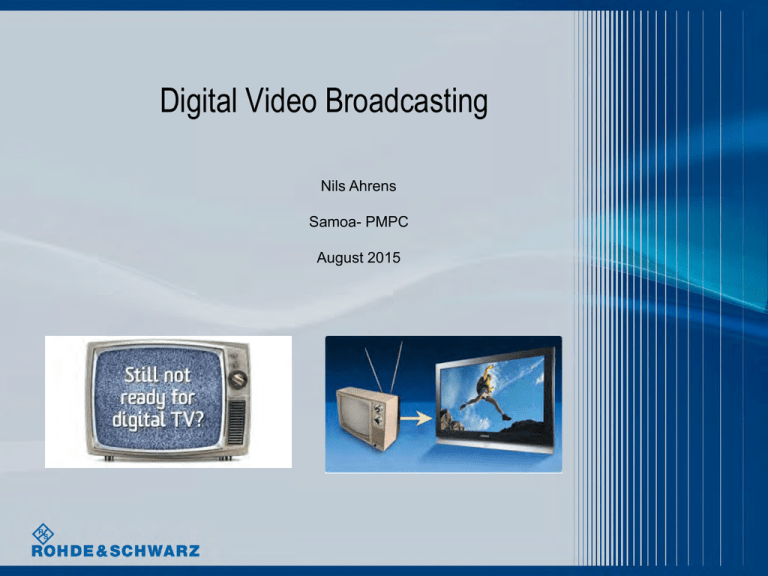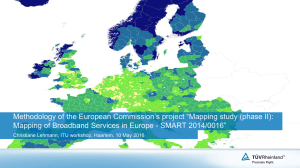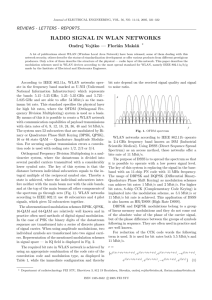Digital Video Broadcasting Nils Ahrens Samoa- PMPC
advertisement

Digital Video Broadcasting Nils Ahrens Samoa- PMPC August 2015 Rohde & Schwarz fields of business l Wireless communications Development and production test solutions for every second mobile phone in the world l Analog & digital TV Transmitters for more than 80 countries l Air traffic control Radiocommunications for more than 200 large airports l Secure communications Radios in use worldwide for all branches of the armed forces l Management of the frequency spectrum Instruments and systems for radiomonitoring and radiolocation for about 150 countries l Service & services To be as close to the customer as possible, nearly 70 locations worldwide Broadcast & Media equipment l High-tech for network operators – Analog and digital TV and radio transmitters of all power classes – Setup of nationwide networks for digital and mobile TV – T&M for maintenance and monitoring of operating networks l Production & Storage solutions – Video Servers – Storage (Online/ nearline, NAS, SAN) – Post Production equipment l High-tech for manufacturers of broadcasting equipment Test solutions from the earliest stages of development up to series production – all from a single source The DVB Project l Founded in 1993 with 8 Members l Currently 280 Member Organisations in 34 Countries l First Generation systems widely adopted worldwide l Many DVB standards and specifications adopted by ETSI l Second Generation systems are already deployed A long term dynamic to build a coherent Family of standards… 1992 1993 1994 1995 1996 1997 From Analog TV to Digital TV 1998 1999 2000 2001 2002 2003 2004 2005 2006 2007 2008 2009 2010 2011 From SDTV to HDTV 2012 …DVB-T2 in line with a family of 2° Generation of standards 2006 2007 2008 2009 2010 2011 2012 Analog TV Switch-Off Process DVB Blue Book Study Mission Specifications ETSI Standard Standardisatio n Receivers Available Implementation Pilots NW Available Experimentations Commercial Launch Deployment Mobile TV: a coherent but specific Family of standards 1998 1999 2000 2001 2002 2003 2004 2005 2006 2007 2008 2009 2010 2011 2012 2013 2014 2015 2016 2017 Analog TV Switch-Off Process From Digital TV to Mobile TV From Mobile TV to “Next Generation Mobile TV” 2018 Analogue / Digital Transition Analogue TV - PAST Digital TVPRESENCE/FUTURE Video – AM Modulation Digital Modulation Sound - FM Modulation Transmission •DVB-S/S2 QPSK •DVB-C/C2 QAM •DVB-T/T2 COFDM Base Band Test Signals in VITS Transport Stream Protocol CCIR17,18,330,331 Blockiness, Blurring, S/N Ratio , Colour, Black/White + Noise Smooth Degradation Picture Quality Hard Degradation – Cliff Effect Good Quality or No Picture Analogue / Digital Transition Analogue TV – PAST /PRESENCE Digital TVPRESENCE/FUTURE Channel Bandwidth Channel Bandwidth •7 MHz / 8 MHz •7 MHz / 8 MHz 1 Program •1 Video •Dual Sound •1 Teletext 1 Transport Stream / Multiple Streams • up to 20 Video Programs •Dual Sound / Surround •Teletext No Interactivity •MetaData Interactivity with return path First Generation Broadcast TV Standards Based on the highest performance consumer technology then available Some Early UK STBs could only support 2K modes Development time/costs minimised by re-using common modules DVB-S Approved in December 1993 Single carrier QPSK mode Single Transport Stream DVB-C Approved in March 1994 Single carrier with 4, 16 and 64QAM modes Single Transport Stream DVB-T Approved in December 1995 2K and 8K COFDM with 4, 16 and 64QAM Two transport streams using Hierarchical Modulation Why Are New Standards Being Developed? New Services Require Increasingly Higher Bandwidths HDTV, 3DTV and Interactive TV New Business Models Demand More Flexible Delivery IP, Mobile and Fixed Broadcasting Increasingly Expensive Spectrum must be Better Utilized Competition for limited resources with telcos New Technologies enable more complex systems Low Cost High Speed Processors High Performance Algorithms DVB ... 2nd Generation Source: DVB-Projekt DVB-S2 EN302 307 Dec 2003 DVB-S2: New Features over DVB-S New Modulation and Forward Error Correction (FEC) 30% Higher bandwidth enables more HDTV, SDTV and IP services Dynamically variable modulation and FEC Optimal bandwidth utilization for different service types Robust delivery in poor weather conditions Multiple Input streams Independent and Flexible Operation between service providers Hierachical Mode for backwards compatibility with legacy STBs Supports non-compliant Transport Stream formats e.g. IP “Null” (PID8191) TS packets need not always be transmitted No need for Transport Stream packetization overhead No conversion simplifies interoperability DVB-S2: New Technology Requirements “New” High Performance FEC (BCH, LDPC) Originally developed in the 1960s Large Frame Size (64800bits) Also adopted for DVB-T2 and DVB-C2 Requires large memory and high processing power New modulation schemes (8PSK, 16APSK, 32APSK) Requires high performance demodulators Modulation can be changed for every Physical Layer Frame Different/variable bit rates for each Input Stream Different FEC for robust reception in bad weather (snow/rain) Requires more complex demodulators DVB-C2 EN302 769 April 2009 DVB-C2: Channel Bonding Unused parts of the spectrum Receiver bandwidth Narrowband interference Selective gain adaptation DVB-C2: Technical Summary Based on DVB-T2 COFDM (4K mode, 2 short guard intervals) Channel raster bandwidth 6 or 8 MHz QPSK … 4096QAM Variable coding and modulation Channel bundling Copes with notches (interfered frequency ranges) Uses the same BBFRAME/FEC structure as DVB-S2 Multiple TS and GSE Single and multiple input streams Data slices Reserved carriers for Peak to Average Power Reduction >50% Higher Bit rates than DVB-C DVB-C2 Bit Rates DVB-T2 EN302 755 May 2008 DVB-T2: Key Commercial Requirements Re-use existing domestic antennae and transmiitter network Support Portable and fixed Receivers At least 30% > capacity than DVB-T Improved SFN Performance Service Specific Robustness Bandwidth and Frequency Flexibility Reduce Peak to Average Power Ratio DVB-T2: New Technology over DVB-T Many new transmission options: New Channel Bandwidths, Guard Intervals and FFT Modes 8 Different Pilot Patterns Extended Carrier Modes Rotated and Q-delayed constellations Multiple Input Single Output (MISO) Modes Peak to Average Power Reduction (PAPR) Modes Modulation dynamically variable for each “COFDM Cell” Every carrier in each symbol independently controllable System/Control data sent in fixed format highly robust symbols DVB-S2 FEC plus extensive time and frequency interleaving Further improves robustness in noisy environments DVB-T2: Benefits over DVB-T New Modulation, FEC and Transmission modes 30 - 60% More Bandwidth enables more HDTV, SDTV and IP services Multiple Input streams (Physical Layer Pipes = PLPs) Common (e.g. SI) Data and service specific (Video, audio) streams Independent and Flexible Operation with multiple service providers Dynamically variable modulation and FEC Mobile (time/frequency sliced) and Fixed Services in same bandwidth Optimal bandwidth utilization for different service types Direct Support for non-TS formats e.g. IP No Transport Stream packetization overhead Repeated (null packets) or common (SI) data need not always be sent No conversion simplifies interoperability DVB Worldwide Source: DVB-Projekt Typical Datarates Digital Broadcast Source Coding: MPEG-2 video SDTV MPEG-4 video SDTV MPEG-4 video HDTV MPEG-1 LII audio Dolby AC-3 audio Teletext 2.5 ... 5 Mbit/s 1.5 ... 3 Mbit/s 8 ... 12 Mbit/s 192 kbit/s 448 kbit/s 260 kbit/s Physical Layer before FEC (net data rate): DVB-S (27.5 MS/s, CR=3/4) 38.01 Mbit/s DVB-S2 (22 MS/S, 8PSK, CR=2/3) 42.58 Mbit/s DVB-S2 (27.5 MS/s, QPSK, CR=9/10) 49.2 Mbit/s DVB-T (16QAM, CR=2/3, g=1/4) 13.27 Mbit/s DVB-T (64QAM, CR=3/4, g=1/4) 22.39 Mbit/s DVB-C (64QAM) 38.15 Mbit/s DVB-C (256QAM) 50.87 Mbit/s DAB/DAB+ 1.2...1.7 Mbit/s Transmission of Information Source Information Source Coding e.g. data compression Channel Coding Modulation Forward Error Correction (FEC) Single Carrier, Multicarrier (OFDM), CDMA, TDMA, ... Transmission link Demodulation Channel Decoding Source Decoding Sink Information (Media, bandwidth, interferer, ...) Transmission of Information: DVB Studio, storage media Headend Modulator, transmitter Transmission link Information Source Coding Channel Coding Modulation Source coding standard: MPEG, ... Transmission standards: DVB-C, J83A/B/C, DVB-C2, DOCSIS, DVB-T/T2, DVB-S/S2 Coax, HFC, FTTH, terrestrial, satellite, ... Demodulation Channel Decoding Source Decoding Information Setop box cable receiver IRD/flat screen cable modem, terr. receiver, sat. receiver MPEG Standards MPEG = Moving Pictures Expert Group MPEG-1 MPEG-2 H.262 MPEG-4 H.264 AVC MPEG-H, ... MPEG-DASH HEVC = High Efficiency Video Coding H.265 HEVC Current Digital Broadcast Transmission Standards DVB – Digital Video Broadcasting (1994 – 2014) DVB-T/T2, -C/C2, -S/S2, DVB-IP DAB/DAB+/T-DMB – Digital Audio Broadcasting (1988, 2007) ATSC – Advanced Television Systems Committee (USA, 1995) ISDB-T – Integrated Service Digital Broadcast – Terrestrial (Japan, 1999) DTMB – Digital Terrestrial Multimedia Broacasting (China, 2004) DVB-T2 + HEVC Source coding: MPEG-2 video SDTV 2.5 ... 5 Mbit/s HEVC = High Efficiency Video Coding HEVC (H.265, MPEG-H): MPEG-4 video SDTV 1.5 ... 3 Mbit/s Datarate by approx. 50% in Mbit/s comp. to H.264 MPEG-4 videoreduction HDTV 8 ... 12 MPEG-1 LII audio 192 kbit/s Dolby AC-3 audio 448 kbit/s Teletext 260 kbit/s Physical layer before FEC (net data rate): DVB-S (27.5 MS/s, CR=3/4) 38.01 Mbit/s DVB-S2 (22 MS/S, 8PSK, CR=2/3) 42.58 Mbit/s DVB-S2 (27.5 MS/s, QPSK, CR=9/10) 49.2 Mbit/s DVB-T (16QAM, CR=2/3, g=1/4) 13.27 Mbit/s DVB-T2: ... 2 Mbit/s DVB-T (64QAM,DVB-T CR=3/4,datarate g=1/4) x 1.722.39 DVB-C (64QAM) 38.15 Mbit/s DVB-C (256QAM) 50.87 Mbit/s DAB/DAB+ 1.2...1.7 Mbit/s Terrestrial Braodcast Channel „man-made noise“ DVB-T2: Closer to the Shannon Limit ... 8 MHz 10 …25 dB Shannon Limit C~1/3 * B * SNR 7.4…50.3 Mbit/s 5…31.7 Mbit/s at 8 MHz band width: 10 dB … 26.7 Mbit/s 15 dB … 40 Mbit/s 20 dB … 53.3 Mbit/s DVB-T2 DVB-T 0 Mbit/s CNR Limits at DVB-T Modulationsart QPSK 16QAM 64QAM Roof antenna Coderate Gauß-Kanal Rice-Kanal RayleighKanal [dB] [dB] [dB] 1/2 3.1 3.6 5.4 2/3 4.9 5.7 8.4 3/4 5.9 6.8 10.7 5/6 6.9 8.0 13.1 7/8 7.7 8.7 16.3 1/2 8.8 9.6 11.2 2/3 11.1 11.6 14.2 3/4 12.5 13.0 16.7 5/6 13.5 14.4 19.3 7/8 13.9 15.0 22.8 1/2 14.4 14.7 16.0 2/3 16.5 17.1 19.3 3/4 18.0 18.6 21.7 5/6 19.3 20.0 25.3 7/8 20.1 21.0 27.9 portable indoor DVB-T2 … more Datarate … Shannon limit … channel capacity C~=1/3 * SNR * B; B = 6/7/8MHz „Fixed antenna“ reception SNR = 18 … 30 dB „Portable indoor“ reception SNR = 10 … 20 dB at 8 MHz bandwidth: 10 dB … 26.7 Mbit/s 15 dB … 40 Mbit/s 20 dB … 53.3 Mbit/s 30 dB … 80 Mbit/s Theoretical max. datarates Datarates at DVB-T Modulation QPSK 16QAM 64QAM CR Guard 1/4 Guard 1/8 Guard 1/16 Guard 1/32 Mbit/s Mbit/s Mbit/s Mbit/s 1/2 4.976471 5.529412 5.854671 6.032086 2/3 6.635294 7.372549 7.806228 8.042781 3/4 7.464706 8.294118 8.782007 9.048128 5/6 8.294118 9.215686 9.757785 10.05348 7/8 8.708824 9.676471 10.24567 10.55617 1/2 9.952941 11.05882 11.70934 12.06417 2/3 13.27059 14.74510 15.61246 16.08556 3/4 14.92941 16.58824 17.56401 18.09626 5/6 16.58824 18.43137 19.51557 20.10695 7/8 17.41765 19.35294 20.49135 21.11230 1/2 14.92941 16.58824 17.56401 18.0926 2/3 19.90588 22.11765 23.41869 24.12834 3/4 22.39412 24.88235 26.34602 27.14439 5/6 24.88235 27.64706 29.27336 30.16043 7/8 26.12647 29.02941 30.73702 31.66845 Portable indoor Roof antenna DVB-T and DVB-T2 DVB-T, „Germany, portable indoor“: 13.27 Mbit/s DVB-T, „fixed antenna“: 22.39 Mbit/s similar modes at DVB-T2: 26.6 Mbit/s „portable indoor“ (32Kext, 64QAM, CR=2/3, g=1/16) 39.7 Mbit/s „fixed antenna“ (32Kext, 256QAM, CR=3/4, g=1/16) DVB and Fall-Off-the-Cliff Go No-Go SNR~12 dB (indoor) SNR~18 dB (fixed) „Fall-off-the-Cliff“ Fall-off-the-Cliff (… from DVB-x1 to DVB-x2 …) Δ Go No-Go SNR1 first on-set of impairments depends on FEC SNR2 total „no-go“ Standard SNR1 [dB] Δ [dB] DVB-T 12 0.3 DAB/+ 6 3 / 0.3 DVB-S 7 0.3 DVB-T2 12 0.03 (Example, approx. values) CNR Limits @DVB-T2 @ BER=10-4 after LDPC Modulation Coderate C/N Gaussian Channel [dB] C/N Ricean Channel [dB] C/N Rayleigh Channel [dB] C/N 0dB Echo Channel @ 90% GI [dB] QPSK 1/2 0.4 0.7 1.5 1.2 3/5 2.2 2.4 3.5 3.2 2/3 3.1 3.4 4.7 4.4 3/4 4.0 4.5 6.0 5.7 4/5 4.6 5.1 6.9 6.5 5/6 5.1 5.7 7.8 7.4 1/2 5.2 5.5 6.6 6.3 3/5 7.5 7.9 9.3 9.0 2/3 8.8 9.1 10.7 10.4 3/4 10.0 10.5 12.4 12.1 4/5 10.8 11.3 13.6 13.3 5/6 11.4 12.0 14.6 14.4 1/2 8.7 9.1 10.7 10.5 3/5 12.0 12.4 14.2 14.0 2/3 13.4 13.8 15.7 15.5 3/4 15.2 15.6 17.8 17.6 4/5 16.1 16.6 19.1 18.9 5/6 16.8 17.4 20.3 20.3 1/2 12.1 12.4 14.4 14.3 3/5 16.5 16.9 18.8 18.8 2/3 17.7 18.1 20.3 20.3 3/4 19.9 20.4 22.6 22.7 4/5 21.2 21.7 24.2 24.3 5/6 22.0 22.5 25.6 25.9 16QAM 64QAM 256QAM Portable indoor Roof antenna Source: DVB-T2 Implementation Guidelines Digital Broadcast Network Services „Multiplex signals“ Coding & MUX Source Source codiering signals: and multiplexing programs („services“) consisting of video, audio, data (live or from server) MPEG-2 TS ETI T2-MI Dig. IP MUX broadcast modulator RF Satellite, terr., coax, fibre, twisted pair cable RF DVB-S/C/T/S2/C2/T2 ISDB-T T-DMB/DAB DMBT ATSC Transmission media Video RF Receiver Audio Data TV with integrated IRD or settop box Digital TV Network TTXT, VBI Headend MPEG-2 TS Matrix Camera R G B Y Cb Cr MPEG-x Encoder SDI L R Modulator& Transmitter MUX MPEG-2 TS Studio Distribution Network (Microwave, Coax, Fibre) MPEG-2 TS RF Signal Receiver Transmission Link (Terrestrial, MPEG-2 Interferences Satellite, TS on Cable) TransInterferences mission on Distribution Network Link MPEG-2 Transport Stream 4 byte TS header 188 bytes 184 Byte payload 13 bit packet identifier = PID 1 bit transport error indicator 1 byte sync byte = 47 hex Basics of a DVB-T2 Network Link fed Transmitters l l Complete Transport Stream Mapped to one PLP (Physical Layer Pipe) Simple Structure with Constant Coding and Modulation for all programs 256QAM, 1/16,3/4, 32k Headend Transmitter 1 f1 HD ENC SD ENC MUX SD ENC Transmitter 3 SI Single Physical Layer Pipe f3 Transmitter 2 f2 Basics of a DVB-T2 Network Link fed Transmitters l l Multiple Transport Stream Mapped to MPLP (Multiple Physical Layer Pipe) Complex Structure with felxible Coding and Modulation for all programs Headend Transmitter 1 f1 HD ENC SD ENC MUX TS out T2- MI Gateway SD ENC Transmitter 3 SI Single Physical Layer Pipe f3 PLP1: 256QAM, 1/16,3/4, 32k PLP2: 64 QAM, 1/8,2/3,8k PLP3: 16QAM, 1/8,1/2, 2k PLP0: Common PLP Transmitter 2 Transmitter f2 SFN Basics of a DVB-T2 Network Link fed Transmitters l l GPS Complete Transport Stream Mapped to one PLP (Physical Layer Pipe) Simple Structure with Constant Coding and Modulation for all programs 1 pps GPS 256QAM, 1/16,3/4, 32k GPS Headend 1 pps 1 pps GPS 10 MHz 10 MHz 1 pps 10 MHz Transmitter 1 f1 HD ENC SD ENC 10 MHz MUX TS out T2- MI Gateway SD ENC Transmitter33 Transmitter SI Single Physical Layer Pipe T2- MI Gateway generates the T2-MI timing information for Link-fed Transmitters f3 f1 Transmitter 2 f1 f2 SFN Basics of a DVB-T2 Network Over the air synchronistation for Re-Transmitters l l GPS Complete Transport Stream Mapped to one PLP (Physical Layer Pipe) Simple Structure with Constant Coding and Modulation for all programs 1 pps 10 MHz 256QAM, 1/16,3/4, 32k GPS Headend 1 pps 10 MHz Transmitter 1 f1 HD ENC SD ENC MUX SD ENC TS out GPS GPS T2- MI Gateway 1 pps T2-MIP 1 pps 10 MHz GPS Single Physical Layer Pipe SI T2- MI Gateway: • • T2-MI timing information for Link fed Transmitters Generates the T2-MIP 10 MHz 1 pps 10 MHz Re -Transmitter 3 Re-Transmitter 2 f2 f2 Re- Transmitter 3 f2 SFN Basics of a DVB-T2 Network Over the air synchronistation for Re-Transmitters Headend Transmitter 1 f1 HD ENC SD ENC MUX SD ENC TS out T2- MI Gateway T2 - MI Transmitter 2 T2-MIP f2 SI Single Physical Layer Pipe T2 receiver T2-MIP extraction Modulator Re-Transmitter 3 f3 T2 receiver T2-MIP extraction Modulator 4 Re-Transmitter 4 f3 ı Network Design ı Gap Filler and Re-transmitters ı DVB-T2 Single Frequency Network ı Total Cost of Ownership 4 Network Design: Total-cost-of-ownership Design and implementation Ensuring a most economic operation ı Network structure: (few) high power Transmitter – high tower (many) low power Transmitter mixed setup ı Network design: Combination of main components driving operational cost ı Network equipment: Energy efficiency Reliability and long term stability Mean time between failure 5 Coverage example Tx Power: 3 kW Tx Power: 6 kW 64 QAM, 32k FFT, CR 2/3, C/N 17dB MORE POWER IS NOT ALWAYS THE BEST SOLUTION 5 Why Low Power Transmitters 1. High Power Transmitters (> 2kW) can not guarantee a 100% coverage 2. Low Power Transmitters do support the High Power Transmission to ensure a better / improved coverage for Shadowed areas (buildings, valleys, etc.) Indoor coverage for Malls Small communities 3. Power Classes 1W – 200W 5 Low Power: Transmitter, Re-transmitter & Gap Filler 1. Transmitter Must have a link fed (ASI / IP Transport stream inputs) VHF & UHF 2. Re-Transmitters RF input & ASI / IP Transport stream inputs Demodulate the DVB-T2 signal to Baseband (Transport Stream) Re-modulate the transport streams to form a regenerated DVB-T2 signal which is then retransmitted Transmits in UHF only 3. Gap Filler (OCR), Transposers RF input only (VHF & UHF) can shift frequency (Transposer) amplify delay and transmit the received DVB-T2 signal without a full re-modulation 5 Re-broadcast systems Difference: input and output frequency fout ≠ fin Output frequency ≠ frequency parent transmitter Transposer Re-transmitter Repeater/ Gap filler Relevance for echo cancellation fout = fin Output frequency = frequency parent transmitter For SFN single frequency network Advantages & disadvantages Low Power Transmitters + Produce a very clean output signal Can be used in a Single Frequency Network (SFN) together with a + Main transmitter Need a Link Feed ( ASI / IP Transport stream) which can be expensive 5 - Advantages & disadvantages Re-Transmitters Produce a very clean output signal , even with a noisy input signal+ No MER degradation + Long processing time between input and output - Cannot be used in a Single Frequency Network (SFN) together with a Main transmitter Can be used to build an independent Low power SFN on a frequency f2 5 + Advantages & disadvantages Gap Fillers Provide a degraded output signal - MER degradation - Can start to oscillate if not careful installed (Echos between Input & Output have to be suppressed with Echo cancellation) Very short processing time between input and output + Can be used in a Single Frequency Network (SFN) together with a + Main transmitter 5




